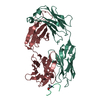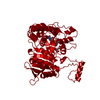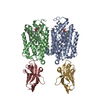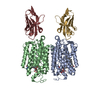+Search query
-Structure paper
| Title | Development of a natural product optimization strategy for inhibitors against MraY, a promising antibacterial target. |
|---|---|
| Journal, issue, pages | Nat Commun, Vol. 15, Issue 1, Page 5085, Year 2024 |
| Publish date | Jun 14, 2024 |
 Authors Authors | Kazuki Yamamoto / Toyotaka Sato / Aili Hao / Kenta Asao / Rintaro Kaguchi / Shintaro Kusaka / Radhakrishnam Raju Ruddarraju / Daichi Kazamori / Kiki Seo / Satoshi Takahashi / Motohiro Horiuchi / Shin-Ichi Yokota / Seok-Yong Lee / Satoshi Ichikawa /   |
| PubMed Abstract | MraY (phospho-N-acetylmuramoyl-pentapeptide-transferase) inhibitory natural products are attractive molecules as candidates for a new class of antibacterial agents to combat antimicrobial-resistant ...MraY (phospho-N-acetylmuramoyl-pentapeptide-transferase) inhibitory natural products are attractive molecules as candidates for a new class of antibacterial agents to combat antimicrobial-resistant bacteria. Structural optimization of these natural products is required to improve their drug-like properties for therapeutic use. However, chemical modifications of these natural products are painstaking tasks due to complex synthetic processes, which is a bottleneck in advancing natural products to the clinic. Here, we develop a strategy for a comprehensive in situ evaluation of the build-up library, which enables us to streamline the preparation of the analogue library and directly assess its biological activities. We apply this approach to a series of MraY inhibitory natural products. Through construction and evaluation of the 686-compound library, we identify promising analogues that exhibit potent and broad-spectrum antibacterial activity against highly drug-resistant strains in vitro as well as in vivo in an acute thigh infection model. Structures of the MraY-analogue complexes reveal distinct interaction patterns, suggesting that these analogues represent MraY inhibitors with unique binding modes. We further demonstrate the generality of our strategy by applying it to tubulin-binding natural products to modulate their tubulin polymerization activities. |
 External links External links |  Nat Commun / Nat Commun /  PubMed:38877016 / PubMed:38877016 /  PubMed Central PubMed Central |
| Methods | EM (single particle) |
| Resolution | 2.7 - 2.88 Å |
| Structure data | EMDB-44293, PDB-9b70: EMDB-44294, PDB-9b71: |
| Chemicals |  PDB-1ai1:  ChemComp-HOH:  PDB-1ai2: |
| Source |
|
 Keywords Keywords | TRANSFERASE / inhibitor / antibiotics |
 Movie
Movie Controller
Controller Structure viewers
Structure viewers About Yorodumi Papers
About Yorodumi Papers








 aquifex aeolicus vf5 (bacteria)
aquifex aeolicus vf5 (bacteria)
